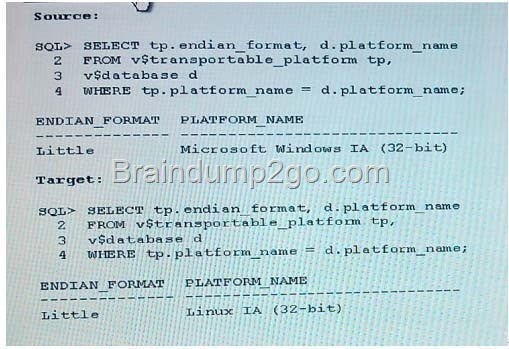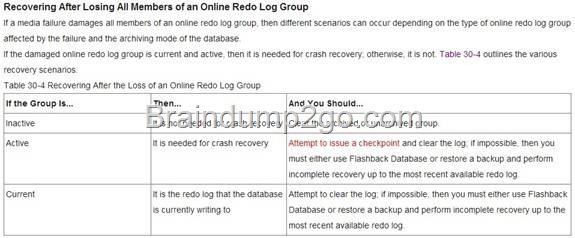QUESTION 1
As part of archiving the historical data, you want to transfer data from one database to another database, which is on another server. All tablespaces in the source database are read/write and online. The source and target databases use the same compatibility level and character sets. View the Exhibit and examine the features in the source and target database.

Which of the following steps are required to transport a tablespace from the database to the target database:
1.Make the tablespace read-only at the source database.
2.Export metadata from the source database.
3.Convert data filed by using Recovery Manager (RMAN).
4.Transfer the dump file and data filed to the target machine.
5.Import metadata at the target database.
6.Make the tablespace read/write at the target database.
A. 2, 4, and 5
B. All the steps
C. 2, 3, 4 and 5
D. 1, 2, 4, 5 and 6
Answer: D
Explanation:
http://docs.oracle.com/cd/E11882_01/server.112/e25494/tspaces.htm#ADMIN11400
read_only–expdp–4-import-read_wrtie
If both platforms have the same endianness, no conversion is necessary. Otherwise you must do a conversion of the tablespace set either at the source or destination database. ![clip_image0024_thumb_thumb_thumb_thu[2]_thumb clip_image0024_thumb_thumb_thumb_thu[2]_thumb](http://examgod.com/l2pimages/0a21b5950acf_86E2/clip_image0024_thumb_thumb_thumb_thu2_thumb_thumb.jpg)
QUESTION 2
Which two statements are true about a duplicate database that is created by using the DUPLICATE command in RMAN? (Choose two.)
A. It is a copy or a subset of the target database.
B. It is opened in RESTRICT mode after a duplicating operation.
C. It is created by using backups and archived redo log files from the target database.
D. It is created with the same database identifier (DBID) as that of target database.
Answer: AC
If you copy a database with operating system utilities instead of the DUPLICATE command, then the DBID of the copied database remains the same as the original database. To register the copy database in the same recovery catalog with the original, you must change the DBID with the DBNEWID utility (seeOracle Database Utilities). In contrast, the DUPLICATE command automatically assigns the duplicate database a different DBID so that it can be registered in the same recovery catalog as the source database.
![clip_image0026_thumb_thumb_thumb_thu[2]_thumb clip_image0026_thumb_thumb_thumb_thu[2]_thumb](http://examgod.com/l2pimages/0a21b5950acf_86E2/clip_image0026_thumb_thumb_thumb_thu2_thumb_thumb.jpg)
QUESTION 3
A user receives the following error while performing a large volume of inserts into a table:
![]()
The issue is resolved by increasing the space quota on the USERS tablespace for the user. But the user may perform such transaction in the future. You want to ensure that the command waits rather than produce an error when such an event occurs the next time. What can you do to achieve this before running the command in the future?
A. Set RESUMABLE_TIMEOUT for the instance.
B. Set the RESOURCE_LIMIT Parameter to TRUE.
C. Enable the database instance to use asynchronous commit.
D. Set the LOG_CHECKPOINT_TIMEOUT parameter to a nonzero value for the database instance.
Answer: A
Explanation:
http://docs.oracle.com/cd/E11882_01/server.112/e25494/schema.htm#ADMIN11584
QUESTION 4
A database has three online redo log groups with one member each. A redo log member with the status ACTICE is damages while the database is running.
What is the first step you should take to solve this problem?
A. Attempt to Issue a checkpoint.
B. Restart the database using the RESETLOGS option.
C. Drop the redo log number and create it in a different location.
D. Perform and incomplete recovery up to the most recent available redo log.
Answer: A
http://docs.oracle.com/cd/E11882_01/backup.112/e10642/osadvsce.htm#BRADV90049

QUESTION 5
How is block-change tracking enabled?
A. With alter database enable block change tracking
B. With alter system enable block change tracking
C. With an init.ora parameter change
D. With an spfile parameter change
Answer: A
Explanation:
You can enable block change tracking when the database is either open or mounted.
To enable block change tracking:
Start SQL*Plus and connect to a target database with administrator privileges.
Ensure that the DB_CREATE_FILE_DEST initialization parameter is set.
SHOW PARAMETER DB_CREATE_FILE_DEST
If the parameter is not set, and if the database is open, then you can set the parameter with the following form of the ALTER SYSTEM statement:
ALTER SYSTEM SET
DB_CREATE_FILE_DEST = ‘/disk1/bct/’
SCOPE=BOTH SID=’*’;
Enable block change tracking.
Execute the following ALTER DATABASE statement:
ALTER DATABASE ENABLE BLOCK CHANGE TRACKING;
You can also create the change tracking file in a location that you choose yourself by using the following form of SQL statement:
ALTER DATABASE ENABLE BLOCK CHANGE TRACKING
USING FILE ‘/mydir/rman_change_track.f’ REUSE;
The REUSE option tells Oracle Database to overwrite any existing block change tracking file with the specified name.
http://docs.oracle.com/cd/E16655_01/backup.121/e17630/rcmbckba.htm#BRADV8125
QUESTION 6
What type of backup is stored in a proprietary RMAN format?
A. Backup set
B. Image copy
C. Backup section
D. Backup group
Answer: A
Explanation:
http://docs.oracle.com/cd/E11882_01/backup.112/e10642/glossary.htm#BRADV90108
Backup set
A backup of one or more data files, control files, server parameter files, and archived redo log files. Each backup set consists of one or more binary files. Each binary file is called a backup piece. Backup pieces are written in a proprietary format that can only be created or restored by RMAN.
Backup sets are produced by the RMAN BACKUP command. A backup set usually consists of only one backup piece. RMAN divides the contents of a backup set among multiple backup pieces only if you limit the backup piece size using the MAXPIECESIZE option of the ALLOCATE CHANNEL or CONFIGURE CHANNEL command.
QUESTION 7
Which dynamic view displays the status of block-change tracking?
A. V$BLOCK_CHANGE
B. V$BLOCK_CHANGE_TRACKING
C. V$BLOCKCHANGE
D. V$BLOCK_TRACKING
Answer: B
Explanation:

http://docs.oracle.com/cd/E16655_01/server.121/e17615/refrn30030.htm#REFRN30030

http://docs.oracle.com/cd/E16655_01/backup.121/e17630/rcmbckba.htm#BRADV8125
QUESTION 8
In a database with the database character set of US7ASCII and a national character set of UTF-8, which datatypes would be capable of storing Unicode data by default?
A. VARCHAR2
B. CHAR
C. NVARCHAR2
D. CLOB
E. LONG
Answer: C
Explanation:
NVARCHAR2 Data Type
The NVARCHAR2 data type is a Unicode-only data type. When you create a table with an NVARCHAR2 column, you supply the maximum number of characters it can hold. Oracle subsequently stores each value in the column exactly as you specify it, provided the value does not exceed the maximum length of the column.
The maximum length of the column is determined by the national character set definition. Width specifications of character data type NVARCHAR2 refer to the number of characters. The maximum column size allowed is 4000 bytes
QUESTION 9
The database Is configured in ARCHIVELOG mode. The database needs to be up 24 X 7. You want to perform user managed backup for the data files of the HR_DATA tablespace. To accomplish the task, you issued the following command:
SQL> ALTER TABLESPACE hi_data BEGIN BACKUP;
Which two statements are true in this scenario? (Choose two.)
A. No transaction on the tablespace is allowed but you can perform queries.
B. The tablespace will automatically come out of backup mode when the file copy is complete.
C. The checkpoint change number is frozen in headers of the data files until the file is removed from backup
mode.
D. The database writes the before image of an entire block to the redo stream before modifying. block tor
the first time.
Answer: CD
Explanation:
http://docs.oracle.com/cd/E11882_01/backup.112/e10642/osbackup.htm#BRADV90002
Making User-Managed Backups of Online Read/Write Tablespaces
You must put a read/write tablespace in backup mode to make user-managed data file backups when the tablespace is online and the database is open. TheALTER TABLESPACE … BEGIN BACKUP statement places a tablespace in backup mode. In backup mode, the database copies whole changed data blocks into the redo stream. After you take the tablespace out of backup mode with the ALTER TABLESPACE … END BACKUP or ALTER DATABASE END BACKUP statement, the database advances the data file checkpoint SCN to the current database checkpoint SCN.
When restoring a data file backed up in this way, the database asks for the appropriate set of redo log files to apply if recovery is needed. The redo logs contain all changes required to recover the data files and make them consistent.
QUESTION 10
You executed the following commands:
SQL> ALTER SESSION SET OPTIMIZER_USE_PENDING_STATISTICS = false; SQL> EXECUTE DBMS_STATS.SET_TABLE_PREFS(‘SH’, ‘CUSTOMERS’, ‘PUBLISH’,’false’);
SQL> EXECUTE DBMS_STATS.GATHER_TABLE_STATS(‘SH’, ‘CUSTOMERS’);
Which statement is correct regarding the above statistics collection on the SH.CUSTOMERS table in the above session?
A. The statistics are stored in the pending statistics table in the data dictionary.
B. The statistics are treated as the current statistics by the optimizer for all sessions.
C. The statistics are treated as the current statistics by the optimizer for the current sessions only.
D. The statistics are temporary and used by the optimizer for all sessions until this session terminates.
Answer: A
Explanation:
http://docs.oracle.com/cd/E11882_01/server.112/e41573/stats.htm#PFGRF94725
By default, the optimizer uses the published statistics stored in the data dictionary views. If you want the optimizer to use the newly collected pending statistics, then set the initialization parameter OPTIMIZER_USE_PENDING_STATISTICS to TRUE (the default value is FALSE), and run a workload against the table or schema:
ALTER SESSION SET OPTIMIZER_USE_PENDING_STATISTICS = TRUE;
QUESTION 11
In Oracle 11g, which recommendations does the SQL Access Advisor generate? (Choose all that apply.)
A. partitioning recommendations
B. statistics collection recommendations
C. index creation recommendations
D. materialized view recommendations
E. materialized view log recommendations
Answer: ACDE
Explanation:
http://docs.oracle.com/cd/E11882_01/server.112/e41573/advisor.htm#PFGRF008
8.1 Overview of SQL Access Advisor
Materialized views, partitions, and indexes are essential when tuning a database to achieve optimum performance for complex, data-intensive queries. SQL Access Advisor helps you achieve your performance goals by recommending the proper set of materialized views, materialized view logs, partitions, and indexes for a given workload. Understanding and using these structures is essential when optimizing SQL as they can result in significant performance improvements in data retrieval. The advantages, however, do not come without a cost. Creation and maintenance of these objects can be time consuming, and space requirements can be significant. In particular, partitioning of an unpartitioned base table is a complex operation that must be planned carefully.
QUESTION 12
Which of the following information will be gathered by the SQL Test Case Builder for the problems pertaining to SQL-related problems? (Choose all that apply.)
A. ADR diagnostic files
B. all the optimizer statistics
C. initialization parameter settings
D. PL/SQL functions, procedures, and packages
E. the table and index definitions and actual data
Answer: BCD
http://docs.oracle.com/cd/E11882_01/server.112/e41573/sql_overview.htm#PFGRF16001

QUESTION 13
You enabled Flashback Data Archive on the INVENTORY table. Which DDL operation is supported on the table after enabling Flashback Data Archive?
A. Drop the table.
B. Partition the table
C. Truncate the table.
D. Add a column to the table.
E. Rename a column in the table.
Answer: D
Explanation:
http://docs.oracle.com/cd/E11882_01/appdev.112/e41502/adfns_flashback.htm#ADFNS640
Oracle 1Z0-053 Exam,1Z0-053 Exam Dumps,1Z0-053 Exam Questions,1Z0-053 Practice Exam,1Z0-053 Practice Test
QUESTION 14
You have a range-partitioned table in your database. Each partition in the table contains the sales data for a quarter.
The partition related to the current quarter is modified frequently and other partitions undergo fewer data manipulations. The preferences for the table are set to their default values. You collect statistics for the table using the following command in regular intervals:
SQL> EXECUTE DBMS_STATS.GATHER_TABLE_STATS(‘SH’,’SALES’,GRANULARITY=>’GLOBAL’);
You need statistics to be collected more quickly. What can you do to achieve this?
A. Set DYNAMIC_SAMPLING to level 4.
B. Set the STATISTICS_LEVEL parameter to BASIC.
C. Set the INCREMENTAL value to TRUE for the partition table.
D. Increase the value of STALE_PERCENT for the partition table.
Answer: C
Explanation:
http://docs.oracle.com/cd/E11882_01/appdev.112/e40758/d_stats.htm#ARPLS68595
Get Your Oracle 1Z0-053 Certification in a short time easily by using the newly updated Braindump2go Dumps